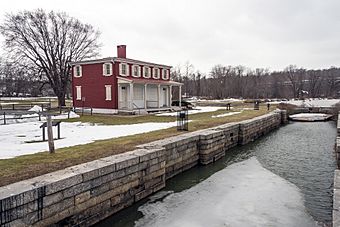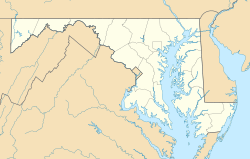Southern Terminal, Susquehanna and Tidewater Canal facts for kids
Quick facts for kids |
|
|
Southern Terminal, Susquehanna and Tidewater Canal
|
|
 |
|
| Location | N of Erie St. between Conesteo St. and the Susquehanna, Havre de Grace, Maryland |
|---|---|
| Area | 33 acres (13 ha) |
| Built | 1836 |
| NRHP reference No. | 76001000 |
| Added to NRHP | May 28, 1976 |
The Southern Terminal, Susquehanna and Tidewater Canal is a special historical area in Havre de Grace, Maryland. It's located in Harford County, Maryland, right on the western bank of the Susquehanna River. This spot was once the busy end point of the Susquehanna and Tidewater Canal.
This canal helped boats move goods between the Susquehanna River and the Chesapeake Bay. Today, you can still see parts of this important site. These include the old Lock Master's House and the remains of the lock. A lock is like a water elevator that helped boats change water levels. You can also see the foundations of a wharf, which was a dock for loading and unloading boats.
Many of the original buildings that supported the canal are no longer standing. However, old city maps show where warehouses, stables, and even a broom factory used to be. This entire area was recognized for its historical importance. It was added to the National Register of Historic Places in 1987.
Contents
What Was the Susquehanna and Tidewater Canal?
The Susquehanna and Tidewater Canal was a waterway built in the 1830s. It was designed to connect inland areas to the Chesapeake Bay. The canal started in Wrightsville, Pennsylvania, and ended here in Havre de Grace, Maryland.
It was a vital route for transporting goods. Farmers and businesses used the canal to move products like coal, lumber, and grain. This made trade much easier and faster during that time.
How Canals Work
Canals are like man-made rivers. They are built to connect different bodies of water. This allows boats to travel where they normally couldn't. Canals often use a system of locks.
A lock is a special chamber with gates at both ends. When a boat enters, the gates close. Water is then either added or removed from the chamber. This raises or lowers the boat to the next water level. It's a clever way to move boats up and down hills or between rivers and bays.
The Southern Terminal's Importance
The Southern Terminal was the end of the line for the canal. It was a very busy place. Boats would arrive here from upriver. Their goods would then be transferred to larger ships. These ships would then sail out into the Chesapeake Bay.
This terminal was a hub of activity. It had warehouses for storing goods. There were stables for the mules that pulled the canal boats. It was a key part of the region's economy.
Buildings at the Terminal
While many buildings are gone, their locations tell a story. The Lock Master's House is one of the few remaining structures. The lock master was in charge of operating the canal lock. This house was their home and office.
The foundations of the bulkhead wharf show where boats docked. This area was essential for loading and unloading cargo. Imagine the hustle and bustle of people and goods moving through this spot.
Why Is It a Historic District?
A historic district is an area with a group of buildings or sites. These places are important because of their history or architecture. The Southern Terminal is a historic district because it shows how canals worked. It also shows how important they were for trade in the 1800s.
Preserving this site helps us understand the past. It teaches us about transportation and industry. It also shows us how communities like Havre de Grace grew.



